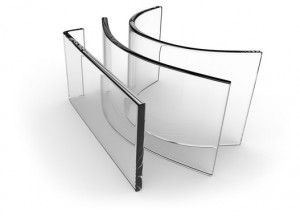Posted by on Mar 14, 2016 in blog
 The term tempered glass is something many of us have heard. But what does it really mean? How does it compare to annealed glass? And how do you know what product is best for your project? Read on for Marcotte’s guide to these unique products.
The term tempered glass is something many of us have heard. But what does it really mean? How does it compare to annealed glass? And how do you know what product is best for your project? Read on for Marcotte’s guide to these unique products.
What is Annealed Glass?
Annealing is the process of slowly cooling hot glass to relieve internal stress. When glass is not annealed, it is more likely to crack when exposed to temperature changes.
What is Tempered Glass?
Tempered glass is “ordinary” or annealed glass that has been put through an extra intensive heating and cooling process. Glass pieces are first cut to size and fabricated (with holes, cut-outs, edge finishing etc). It’s important that all fabrication be done before tempering – once the tempering process is complete, the glass can not be altered in any way!
The fabricated glass is fed through a tempering oven, which heats the glass to an amazing 620 degrees Celsius. From the oven, it goes through the “quenching” process, which uses high-pressure, focused air blasts to quickly cool the glass. Quenching cools the outer area of the glass much quicker than the center, causing the center to remain in tension and the outer surfaces to go into compression.
All that tension and compression give tempered glass amazing tensile strength and creates a unique breaking pattern.
Compare Your Options
Tempered Glass
- Four to six times stronger: has a breaking point between 10,000 psi and 24,000 psi
- Safe break: shatters into many small, relatively harmless pieces
- No modifications: glass can not be cut, fabricated, or altered in any way once tempering is complete. Attempting to fabricate tempered glass almost always causes the piece to shatter.
- Weak edge: light taps along the edge of the glass (where tensile strength is greatest) will frequently cause the piece to break.
Annealed Glass
- Standard strength: average breaking point of 6,000 psi
- Sharp shards: breaks into large, sharp pieces that can be very dangerous
- Flexibility in design: annealed glass can be cut, fabricated or otherwise altered throughout its lifetime. This makes it possible to re-purpose existing glass.
- Consistent strength: while not as strong as tempered glass overall, annealed glass edges are not considered a weak point and stand up to stress better than tempered glass.
What’s Best For You?
Tempered glass is considered a safety product, and is used wherever the physical safety of people is a concern. Shower enclosures, railing systems, glass shelves, and structural glass projects would all use tempered glass. Tempered glass is also used in vehicles, in door-lites, and for glass table tops.
Annealed glass is appropriate for lots of projects around the home or office, where a person’s immediate safety isn’t a concern. Residential and commercial windows almost always use annealed glass, along with picture frames and other decorative pieces. While glass table tops should be tempered, the glass table protectors – that is, any piece of glass resting on top of a table and fully supported throughout – is usually best done using an annealed product.
Marcotte Glass is happy to supply our customers with a wide range of both tempered and annealed products, all custom made to suit your exact needs. If you’re not sure what product best suits your project, our friendly and knowledgeable staff is always available to answer questions! Contact us to learn more.





